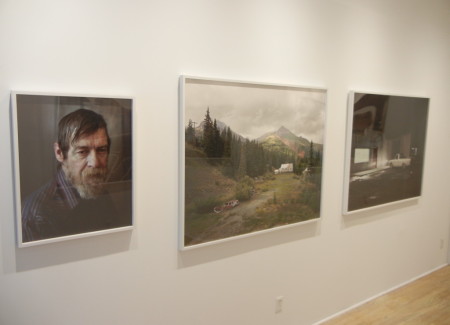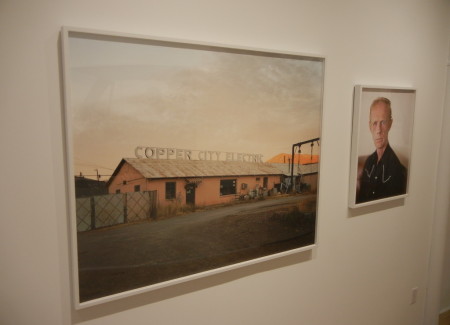JTF (just the facts): A total of 14 large scale color photographs, framed in white and unmatted, and hung against white walls in the single room gallery space. All of the works are archival pigment prints, made between 2010 and 2012. The prints are available in three sizes (or reverse): 22×27 (in editions of 10), 32×40 (in editions of 5), and 40×50 (in editions of 3); there are 5 prints in the small size, 3 in the middle size, and 6 in the large size on view. A monograph of this body of work was published in 2013 by Silas Finch (here, now in a second edition) and was shortlisted for the Paris Photo/Aperture First Book Award. (Installation shots below.)
Comments/Context: In the past decade, dozens of talented contemporary photographers, all investigating their own separate and distinct artistic interests, somehow looked up and found themselves in roughly the same place, as though following a silent but surprisingly persuasive homing beacon. That place was the 21st century American wilderness, not the one captured with majestic, heroic grandeur in the Ansel Adams days, but the one out beyond where the depressed boom towns now thin out, where the electric grid stops, and where the land now sits quietly, slowly recovering from the rough treatment it has endured at our hands over the previous decades. It’s the place where the people have been left behind, or the one they have deliberately returned to to get away from the modern world.
Given the density of talent pursuing thoughtful variations on this theme, we might conclude that, even though we may have overlooked it, many or perhaps all roads now lead to this same place. If you’re an artist and you want to extend the footsteps of Evans, Lange, and the FSA photographers, you might end up here. If you want to follow up on the environmental and suburban sprawl investigations of the New Topographics photographers, you might end up here. If you want to examine the real life consequences of and reactions to our recent economic/political bust, you might end up here. If you revel in the textures of decaying surfaces or want to update the vistas of the 19th century Romantic painters, you might end up here. If you want to explore the edges of failed masculinity and the changing roles of marginalized men, you might end up here. In short, whether you are a realist or a poet (or both), the backwaters of the American West may be your new second home, and a smart list of photographers like Soth, Kurland, Foglia, Potter, and many others is evidence that this congregation of attention isn’t just a coincidence.
Bryan Schutmaat’s place in this ever expanding crowd has been secured by the strength of his portraits. While this show does include a handful of well seen landscapes and town views (especially the long sweep of the city of Tonapah decorated with junked cars, abandoned tires, makeshift shacks, and dusty snow, and a rugged mountain landscape punctuated by an abandoned homestead and a rusty car), it’s his images of people (nearly all men) that resonate with the most durable power.
Seen in their trucks, in their cluttered yards, on the broad sweep of the prairie, or in close up head shots, his faces document the complex emotional landscape of an empty mining town or a failed mountain community. In the older men, Schutmaat finds greasy hair, scraggly beards, weathered faces, and hollowed out expressions, showing us a mix of stubborn determination and depressed resignation; these are men that have seen the hard times and the disappointments, and have gotten by with worn down stoicism and perseverance. The middle aged men are perhaps the saddest, as they seem to have realized that the hopes they once held aren’t going to come true; they have the appearance of hard work, of matted hat heads, dirty clothes, three day stubble, and too many jobs to do to get by. The lone young man in this group seems to look to the horizon with a shard of optimism in his demeanor – whether it is hope for a better life in his current place or hope to one day get away isn’t entirely clear; he’s like a lone flower blossoming in a field of destruction.
Several of Schutmaat’s technical decisions contribute to the success of these pictures. First, the tonal palette has been consciously muted; his colors wander through greys, greens, and browns, with almost no bright highlights or eye catching details. The result is a mood that is subdued, matching the cloudy, faded, weather beaten patina of the environment. Second, Schutmaat uses a shallow depth of field in the close up portraits, placing our attention on the plane of the eyes and allowing both the foreground noses and background details to fall into loose blur. In a work like Ted, it brings us right in close to see the topology of his quiet sorrow, his fuzzy out of focus features a supporting element in depicting his conflicted demeanor.
In the end, there is a desolation in these pictures that packs a punch like a mournful blues melody. In Schutmaat’s men, we see loneliness, and isolation, and the romantic myths of frontier self-determination slowly eroded away. But the fact that there is beauty to be found here too gives the images their seductive balance. There is turmoil in the hearts of these men, but Schutmaat’s empathy makes us root for them, even in the face of such dispiriting odds.
Collector’s POV: The prints in this show are priced as follows, based on size. The 22×27 prints are $3000 each, the 32×40 prints are $5000 each, and the 40×50 prints are $7000 each. Schutmaat’s work has little secondary market history, so gallery retail remains the best option for those collectors interested in following up.










